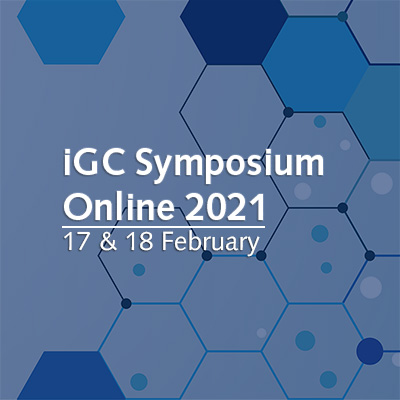
iGC Symposium Online 2021
Featuring leading experts in iGC from across the academic and industrial spectrum, the Conference Agenda will explore the latest findings and insights for iGC, as well as the innovative applications you can use in your own work.
| Responsible | Daniel Villalobos |
|---|---|
| Last Update | 16/02/2023 |
| Completion Time | 7 hours 25 minutes |
| Members | 122 |
Talk: Powder Characterization in Additive Manufacturing
Speaker: Dr. Kristian Waters, McGill University
Speaker: Dr. Kristian Waters, McGill University
Speaker: Dr. Maria Holuszko, University of British Columbia Flotation is the main concentration process for recovery of valuable minerals, and it has been successfully applied for more than hundred years in mining industry. In simple terms, in froth flotation mineral particles are made hydrophobic by adsorption of chemical reagents referred to as collectors then the hydrophobic minerals are attached to the air bubble and carried over to the top of the flotation cell to be collected as a concentrate. In flotation, many interfacial interactions occur between gas/liquid/solid (mineral) surface molecules. The interfacial behavior of minerals is controlled by the surface energy of the mineral (solid). The wetting process occurs when the adhesion force between a solid-mineral and liquid is greater than the cohesion force between the liquid’s molecules while non-wetting (hydrophobicity) condition is required for flotation (Leja, 1983). Many methods have been developed to study the wetting characteristics of minerals relevant to flotation. Some of these methods include contact angle, film flotation, displacement pressure, and penetration rate, heat of immersion, immersion/sink time, imbibition time, and induction time measurements of fine powders (Buckton, 1990; Good and Li, 1976; Arkhipov et.al.2011). However, there are many limitations to each of the methods, and in all of these methods physical properties of particles like size, shape affect the final results, while surface energy of solids can provide good means for evaluation of degree of hydrophobicity for particulate solids. In addition, IGC system was shown to be successfully used to map the surface energy of mineral particles and provide parameters to evaluate their wettability independently of minerals’ physical characteristics. It has been shown that the surface energy distribution i.e. the distribution of dispersive and acid/base surface energy components can be used for correlation with the addition of reagents and response of minerals in flotation (Ali et al. 2013; Mohammedi-Jam et al., (2014). In addition, the hydrophilicity index can be derived to assess the surface properties of heterogeneous minerals systems such as coal (Niu et al., 2018). Froth flotation has also been used to recover various types of plastic from their mixtures (Wang et al., 2013; Wang et al., 2015. Plastic flotation is usually used for selective separation for the purpose of reuse or to obtain a pure quality product (Fraunholcz, 2004; Shent et al., 1999). In mineral flotation, the challenge is typically in making the minerals’ surfaces selectively hydrophobic. While in plastic flotation the opposite is true, since most of the plastic polymers are highly hydrophobic, plastic surfaces need to be made selectively wettable-hydrophilic if an efficient separation of different plastics is required. In plastic flotation, a variety of depressants are usually studied to facilitate selective bubble-particle attachment while exploiting differences between surface energy of various plastic polymers for achieving selectivity (Buchan, R., & Yarar, B. (1995). The attempts are also made to investigate the mechanisms of their adsorption on different plastics and the IGC can be used to facilitate development of such understanding. The presentation will review practical application of IGC in flotation as applicable to mineral processing as well as in flotation of plastic and non-metal fractions from e-waste recycling streams.
... Surface Free Energy Distribution Profiles Speaker: Dr. Vibha Puri, Bristol-Myers Squibb Unanticipated changes in the surface properties of mechanically-activated micronized drugs are a leading cause of variability in drug product performance. To address this issue, a post-micronization annealing step is often introduced. However, there is limited understanding of the material changes that occur during annealing. We present a case study on the use of surface free energy (SFE) measured by inverse gas chromatography to monitor surface-specific changes during annealing. We also use other orthogonal techniques (atomic force microscopy, RH perfusion microcalorimetry) to conduct additional analysis. Further, the SFE descriptor enabled us to differentiate the extent of mechanical activation of the neat micronized drug and co-micronized drug-excipient blends. This study’s primary contribution is to identify SFE as a tool for characterizing post-micronization material changes over storage. Vibha Puri1, Jagdeep Shur2, and Ajit S. Narang3 1Drug Product Development, Bristol-Myers Squibb, USA, 2Nanopharm Ltd, an Aptar Pharma Company, U.K., 3Small Molecule Pharmaceutics, Genentech, Inc., USA
Speaker: Dr. Douglas Gardner, University of Maine The production of cellulose nanofibers by disk refining lignocellulosic feed stocks as aqueous suspensions results in particles exhibiting dimensions ranging from nano- to micron-scale with surface chemistry and morphological attributes that are challenging to study. Obtaining dry cellulose nanofibers for study is also challenging because of the propensity of the fibers to agglomerate during the drying process. So, particles that exist as nanoscale in aqueous suspensions may end up as micron scale agglomerates. Surface characterization techniques that have proven to be quite useful in studying cellulose nanofibers include inverse gas chromatography, nuclear magnetic resonance and atomic force microscopy. It is the objective of this presentation to provide information on the surface characteristics of cellulose nanofibers as a function of energy input during the disk refining process. Understanding how surface chemistry and morphology change as a function of processing time and energy will help guide future work on the application of cellulose nanofibers in various products.